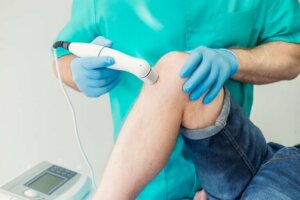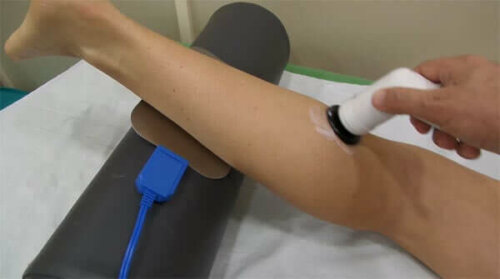What is Diathermia in Physical Therapy?

If you see a physical therapist because of an injury, they’ll probably mention diathermia. Don’t let this strange word make you nervous! On the contrary, treatment with diathermia is good news since it’s quick and pleasant. So, what is it, how does it work, and what practical applications does it have?
The basics
Diathermia consists of heating tissues in the body using an electromagnetic field. In other words, it falls into the category of thermotherapy. In fact, due to the nature of the treatment, it’s also under the umbrella of electrotherapy.
Diathermia treatment involves applying heat for different periods of time and with varied intensity, depending on the problem. Diathermia hasn’t been around for very long, so there’s still a dearth of scientific evidence to back up its effectiveness.
However, given the known benefits of thermotherapy, we expect that future studies will confirm the utility of diathermia. After all, the little evidence we have so far has been positive.
How does it work?
Therapists use diathermia in different ways depending on whether the desired effect is superficial or deep. The therapist might use two plates, an ultrasound-type wand, or induction coils. Whatever the implement, the machine is designed to send electric impulses to stimulate damaged tissue.

The applied heat triggers an increase in blood flow to the area, as well as decreased inflammation and a feeling of relaxation. These three classic components of thermotherapy are helpful for treating many kinds of injuries, and the reason that these techniques are so popular.
There are different kinds of diathermia: ultrasonic, short wave, microwave, and radiofrequency. Therapists choose a technique based on the needs of the patient. They can use a more intense and short treatment, or a more prolonged and relaxing one.
Therapeutic uses of diathermia
Given that this therapy is simply a way to direct heat to certain tissues, it’s useful in many situations. Here are some examples:
- Therapists use it to treat muscle spasms and their trigger points or to accelerate the recovery process after a tear.
- Diathermia can be useful to treat tendonitis or other specific tendon injuries.
- Damaged ligaments (i.e. a sprained ankle) can also benefit.
- Some therapists even use it to treat neurological problems such as headaches, sciatic pain, etc.
- It’s also useful for joint problems such as capsulitis, arthritis, arthrosis, and even rheumatic processes.

- Diathermia can improve circulation and treat pathologies that cause inflammation. It can also promote the reabsorption of edemas.
- Aid in the wound healing process. It can speed up healing, as well as ensure good mobility of the scar tissue.
The contraindications for diathermia are the same as those for thermotherapy in general. The only time that it should be used with caution is when the patient has a pacemaker, is pregnant, has a tumor, or is dealing with some kind of infection.
Lastly, it’s not a good choice if the patient is taking any kind of blood thinner, or they’re hemophilic.
In conclusion, if your physical therapist wants to do a few diathermia sessions, relax. Find a comfortable position, and let the heat and your metabolism do the rest.
If you see a physical therapist because of an injury, they’ll probably mention diathermia. Don’t let this strange word make you nervous! On the contrary, treatment with diathermia is good news since it’s quick and pleasant. So, what is it, how does it work, and what practical applications does it have?
The basics
Diathermia consists of heating tissues in the body using an electromagnetic field. In other words, it falls into the category of thermotherapy. In fact, due to the nature of the treatment, it’s also under the umbrella of electrotherapy.
Diathermia treatment involves applying heat for different periods of time and with varied intensity, depending on the problem. Diathermia hasn’t been around for very long, so there’s still a dearth of scientific evidence to back up its effectiveness.
However, given the known benefits of thermotherapy, we expect that future studies will confirm the utility of diathermia. After all, the little evidence we have so far has been positive.
How does it work?
Therapists use diathermia in different ways depending on whether the desired effect is superficial or deep. The therapist might use two plates, an ultrasound-type wand, or induction coils. Whatever the implement, the machine is designed to send electric impulses to stimulate damaged tissue.

The applied heat triggers an increase in blood flow to the area, as well as decreased inflammation and a feeling of relaxation. These three classic components of thermotherapy are helpful for treating many kinds of injuries, and the reason that these techniques are so popular.
There are different kinds of diathermia: ultrasonic, short wave, microwave, and radiofrequency. Therapists choose a technique based on the needs of the patient. They can use a more intense and short treatment, or a more prolonged and relaxing one.
Therapeutic uses of diathermia
Given that this therapy is simply a way to direct heat to certain tissues, it’s useful in many situations. Here are some examples:
- Therapists use it to treat muscle spasms and their trigger points or to accelerate the recovery process after a tear.
- Diathermia can be useful to treat tendonitis or other specific tendon injuries.
- Damaged ligaments (i.e. a sprained ankle) can also benefit.
- Some therapists even use it to treat neurological problems such as headaches, sciatic pain, etc.
- It’s also useful for joint problems such as capsulitis, arthritis, arthrosis, and even rheumatic processes.

- Diathermia can improve circulation and treat pathologies that cause inflammation. It can also promote the reabsorption of edemas.
- Aid in the wound healing process. It can speed up healing, as well as ensure good mobility of the scar tissue.
The contraindications for diathermia are the same as those for thermotherapy in general. The only time that it should be used with caution is when the patient has a pacemaker, is pregnant, has a tumor, or is dealing with some kind of infection.
Lastly, it’s not a good choice if the patient is taking any kind of blood thinner, or they’re hemophilic.
In conclusion, if your physical therapist wants to do a few diathermia sessions, relax. Find a comfortable position, and let the heat and your metabolism do the rest.
All cited sources were thoroughly reviewed by our team to ensure their quality, reliability, currency, and validity. The bibliography of this article was considered reliable and of academic or scientific accuracy.
- González Roig J; Martínez Sánchez H; López Trasobares E; Carmenaty Baglans I; Delgado Ramírez M. Estudio comparativo entre la acupuntura, el láser y la diatermia, en el tratamiento del dolor lumbosacro crónico / Comparative study among acupunture, laser and diathermy in the treatment of chronic sacrolumbar pain. Rev. cuba. ortop. traumatol;4(2):67-77. 1990.
- Cruz Ornetta V. Evaluación de campos electromagnéticos de la diatermia terapeútica por microondas en el Perú. Paradigmas. Vol. 3 Núm. 1. 2011.
- Alba G, Coronados V, Cisneros P, Ortiz R, Rodríguez R, Peraza M, Violt G. Protocolo de actuación con el sistema de descompresión espinal y diatermia en pacientes con lumbalgia mecánica. Rev Cub de Med Fis y Rehab 2018; 10 (1).
This text is provided for informational purposes only and does not replace consultation with a professional. If in doubt, consult your specialist.








